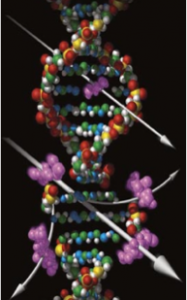Welcome to the Britt Lab


We’re interested in the maintenance of genomic stability in plants. Plants face challenges to genomic stability that animals do not experience. Plants have to grow in the presence of sunlight (and UV), and can’t walk away from toxic chemicals. Their development is “inside out” compared to that of animals- while animals set aside their germline (sex cells) early in development, the differentiation of the plant germline occurs towards the end of its development, after many rounds of cell division. Thus the cells that will produce the next generation of plants have had more opportunities to experience an error of replication. On the plus side, plants don’t die from cancer, as their their cells cannot metastasize (crawl around), and their developmental patterns are very flexible- any organ can be regenerated. This means that localized deregulation of growth is not a lethal event.
We use Arabidopsis thaliana, the “mouse eared cress”, as a model system, and employ genetic and genomics approaches. We currently focus on the developmental specificity of DNA damage response. In Arabidopsis, different kinds of cells have different programmed responses to radiation- some (but not many!) will commit suicide, some will stop DNA replication (either temporarily, or permanently), and some will continue to replicate their DNA but will no longer undergo cell division, exhibiting early differentiation from stem cells into terminal cell types. The figure above shows seedlings grown from unirradiated (top) vs. gamma-irradiated (bottom) seeds. Clearly different embryonic tissues exhibit very different responses to IR-induced damage!
Plants use many of the same mechanisms (and enzymes) that animals use to detect and respond to DNA damage, and so they make good models for repair and response in mammals. But plants have also evolved, independently, some unique responses.
We are also interested in double strand break repair and the development of methods for precise genetic engineering of plants.
In a third research area, we are continuing the late Dr. Simon Chan’s work on the induction of haploidization in Arabidopsis via the modification of the centromeric histone CENH3 (aka CenpA). We’re seeing if the “Chan/Ravi” technique, and some related approaches, can be extended to generate haploid crop pants (cassava, plantain, and tomato). Haploid plants, once chemically doubled to create diploids, are very valuable for breeding, mapping, and strain construction, as they’re homozygous at all loci. Induction of “doubled haploids” allows breeders to generate “inbred” lines in a single step, skipping the many generations required for true inbreeding. These inbred lines can then be screened for value in the production of hybrid crops.
The Britt lab is located in the Dept. of Plant Biology at the University of California, Davis. Dr. Britt is a member of the Plant Biology, BMCDB, and Genetics Graduate Programs.